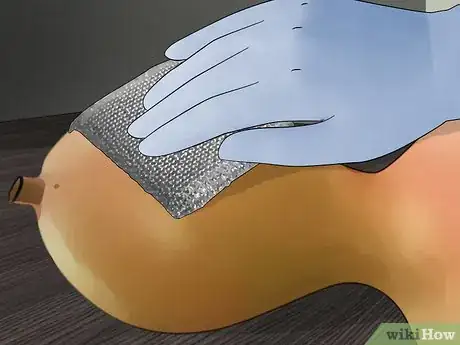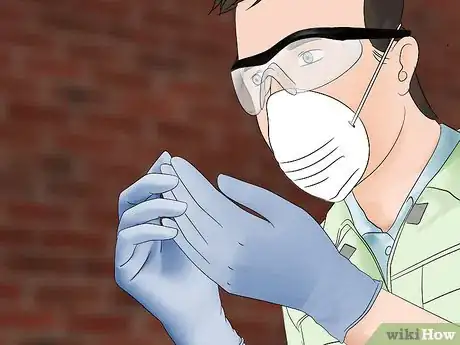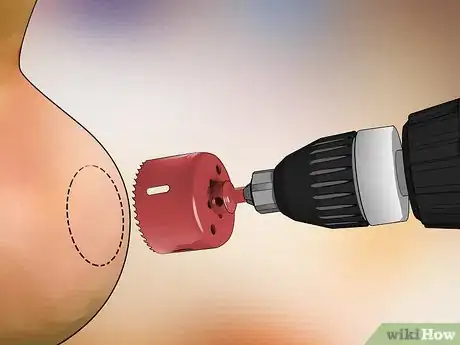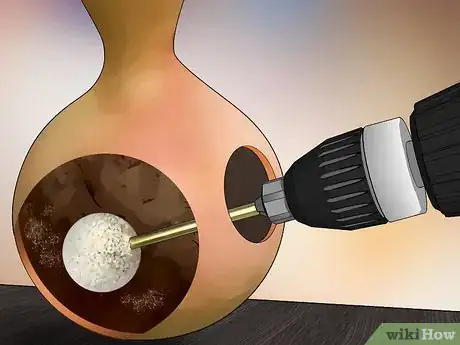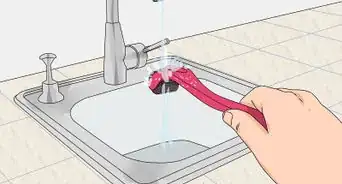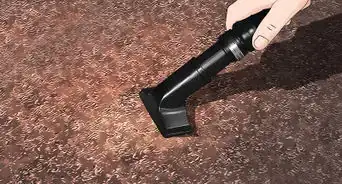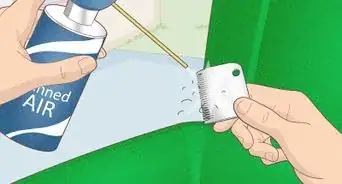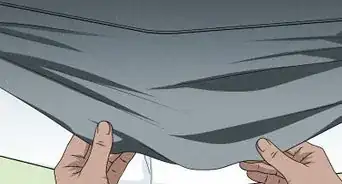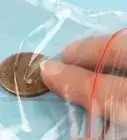This article was co-authored by wikiHow Staff. Our trained team of editors and researchers validate articles for accuracy and comprehensiveness. wikiHow's Content Management Team carefully monitors the work from our editorial staff to ensure that each article is backed by trusted research and meets our high quality standards.
This article has been viewed 66,407 times.
Learn more...
Gourds, due to their hard shells that last indefinitely after being cured, are popular in craft products. With gourds, you can make beautiful products such as birdhouses, decorative bowls, rattles, and more. Once the gourd has grown brown and dried on the vine, it is ready to be picked and cleaned. To clean your gourds, submerge the gourd in water, scrub off the mold, dry the gourd, then cut it open and scrape out the seeds and pulp.
Steps
Washing the Exterior
-
1Soak the gourd in water for 30 minutes. Submerge the gourds in buckets of water. Allow the skins to soak. If you do not have buckets, other options include covering them with wet towels or letting them sit out under a sprinkler. Allow them to sit for 30 minutes and the hard gourd skin will soften.
- Avoid using hot water, as this can cause the gourd to crack.
-
2Put on gloves and a face mask. Before cleaning the gourd, take safety precautions. Work in a well-ventilated area. Put on rubber kitchen gloves and a dust mask to protect against the mold that grows on the outside of gourds.[1]Advertisement
-
3Scrub the gourds to remove the skin. Use a copper dish scrubber, a non-scratch scouring pad, or other similar cleaning utensil. Press hard while scrubbing to remove the skin, but try to hold back a little to avoid scratching the gourd itself. This can be done while the gourd is wet or in water. Water exposure makes the skin come off easier and, as long as the gourd doesn’t have holes in it, won’t damage the gourd.
- Avoid using steel wool. It tends to leave metal particles on the gourd.
-
4Use detergent or bleach to remove mold. When the mold forms a white film that’s tough to get out, try squirting liquid dish soap over it. The gourd is tough, so any regular dish soap you use will work. Scrub the gourd again. When the mold still won’t go away, try dipping the gourd in a 10% solution of bleach (ten parts water to one part bleach) or about two cups (473 mL) of chlorine bleach to five gallons (18.9 L) water and scrubbing the gourd.[2]
-
5Scrape off stubborn mold. When washing and scrubbing doesn’t seem to work, a sharp knife or sander may work. Carefully place these objects against the skin of the gourd. Scrape off the mold, taking care not to cut into the gourd.[3]
-
6Dry the gourd. You can rinse the gourd again to make sure all the skin is gone. Once this is done, leave the gourd in a shady, ventilated area. It should dry quickly.
-
7Sand off any leftover skin. This is not required, but can be done to ensure the gourd is skinless or even extra smooth. Use a sanding block, sandpaper, or a sander. Start with 80 grit paper and switch to a higher grade of sandpaper for a smoother gourd.
Cleaning out the Interior
-
1Put on safety gear. Rubber gloves are useful again for handling gourds that may still have mold or other harmful substances on them. Work in a ventilated environment and wear a dust mask because of the dust inside the gourd. Finally, wear eye protection when using power tools.
-
2Cut the gourd. The way you cut the gourd and the tool you use depends on your intended use. For example, a power drill can be used to make a hole for a birdhouse, or you can cut an opening using hand saws and rotary cutters to make a decorative container.
-
3Scrape out the inside of the gourd. Birds don’t mind the papery pulp and seeds inside the gourd, but you will have to get rid of them when making something other than a birdhouse. Tools with long handles, such as clay sculpting tools, spoons, and screwdrivers can help you reach the seeds and scrape pulp off the walls of the gourd.
- When the opening is too small or the seeds are in a tough ball, you can soak the gourd in warm water for 30 minutes. However, it will take several hours for the gourd to dry.
- Pulp and seeds can be saved for projects such as replanting or pulp sculptures by straining them and letting them dry in a single layer.[4]
-
4Sand the inside of the gourd. Depending on your product, such as when making a bowl, you may wish to make the inside of the gourd smooth. Use your sanding tool. Afterwards, you may wish to add primer, dye, or paint to decorate the gourd.
- Gourd Ball cleaner or a mushroom tool, which is used to cut off the caps of mushrooms, can also be used to sand the inside of the gourd.
Community Q&A
-
QuestionDo I have to clean the inside even if I am just painting the outside for decoration?
 Community AnswerYou don't have to; but if you don't, the inside will look older than the outside.
Community AnswerYou don't have to; but if you don't, the inside will look older than the outside. -
QuestionWill gourds get damaged if they are picked off of the vine before they dry?
 Community AnswerIt's best to pick them after the first frost, then store them in a dry and cool place so they harden completely.
Community AnswerIt's best to pick them after the first frost, then store them in a dry and cool place so they harden completely.
Warnings
- Gourds contain mold and dust that are harmful to breathe. Wear protective gear, including rubber gloves and a dust mask, and work in a well-ventilated area.⧼thumbs_response⧽
- Wear eye protection when using power tools.⧼thumbs_response⧽
Things You’ll Need
- Water
- Bucket, sprinkler, or towel
- Copper scrub brush or scouring pad
- Sanding tool
References
About This Article
To clean a gourd, start by soaking it in water for 30 minutes to soften the skin, then using a scouring pad to rub the skin off. Next, scrub the gourd with liquid dish soap to remove the white mold from the surface. If this doesn’t get rid of all the mold, try soaking the gourd in 2 cups of bleach diluted with 5 gallons of water before scrubbing it again. Once you’ve removed all the mold, allow the gourd to dry in a well-ventilated area. Then, use a drill or rotary cutter to cut a hole in the gourd, and scrape out the seeds and pulp with a spoon. For advice on how to sand the inside of a gourd so you can use it as a bowl, read on!


